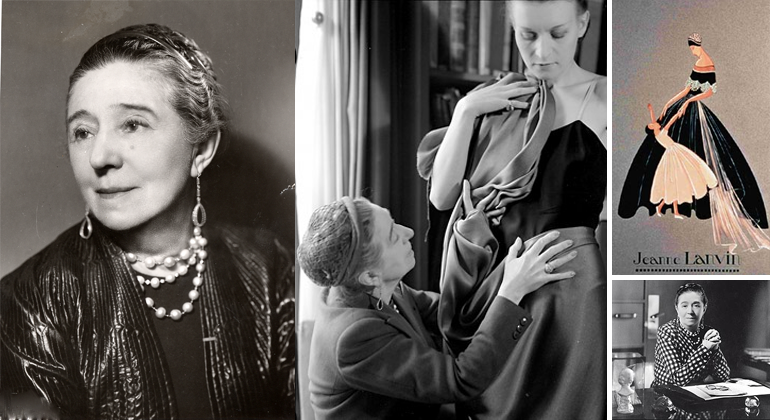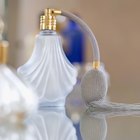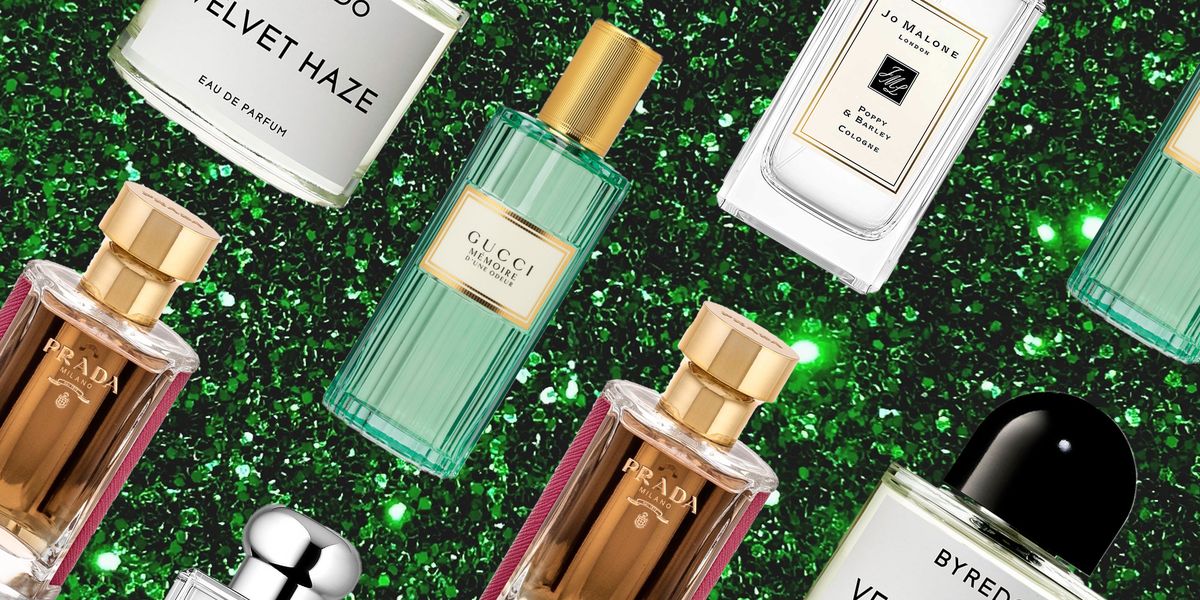
Do You Like It? Share It:
HAUTE COUTURE Jeanne Lanvin (1867-1946)
House of Lanvin, Oldest Fashion House in the World
Jeanne Lanvin was born in Brittany, France, in 1867. She was the eldest of 10 children. She became an apprentice milliner at Mme Félix in Paris at the age of 16. She then trained as a dressmaker at the House of Talbot. By 1890, Jeanne Lanvin was nicely settled in her own millinery shop at 22 rue du Faubourg Saint-Honoré, in Paris. In 1895, she married her first husband, Count Emilio Pietro, an Italian nobleman. They had one daughter who was born in 1897, Marguerite (a.k.a. Marie-Blanche de Polignac). The couple divorced in 1903. In 1907, Jeanne Lanvin married her second husband, Xavier Melet, a journalist at the newspaper Les Temps. He later became the French consul in Manchester, England (Nation Master Encyclopedia; Posh Couture, 2011).
Having a flair for couture Mme Lanvin started to sew beautiful dresses for her younger sister and her daughter Marguerite. Her attractive mother-daughter outfits were in high demand by mothers who also asked her to create clothing for them. As her reputation grew, Jeanne Lanvin abandoned millinery and concentrated on the creation and sale of high fashion clothing. In 1909, she joined the Syndicat de la Couture thereby establishing her formal status as a couturier. Mme Lanvin became one of the most impressive and influential designer of the 1920s-1930s. She designed clothing for the Queens of Italy and Romania, English princesses, and dressed film actresses like Marlene Dietrich, Mary Pickford, and Yvonne Printemps (Nation Master Encyclopedia; The Fashion Model Directory, 1998-2001).
CRAFTSMANSHIP
Mme Lanvin was recognized for her innovative approach to fashion as well as for her fine craftsmanship. When she conceived a garment she would select fabrics, colors, shaping techniques, and ornamentation which she deemed would enhance a woman’s femininity, beauty, and youthfulness.
She would use softly flowing fabrics such as chiffon, lace, organza, silk, tulle, taffeta, and satin for fashioning her dresses and gowns. For more sturdy and elegant types of clothing she made use of luxurious fabrics such as brocades, velvet, and gold and silver textiles (Boucher, n.d, p. 393; Posh Couture, 2011).
Understanding the magic of color to bring to life a garment Mme Lanvin made use of both pastel and bold colors, particularly delicate shades of pinks, and a certain shade of blue which came to be known as “Lanvin Blue” (Fact Monster, 2000-2011).
Lanvin was a very skilful seamstress who was best known for her multilayered cuts, and parallel stitching (The Fashion Model Directory, 1998-2001).
Mme Lanvin liked to decorate her garments with a variety of intricate trimmings and imaginative adornments such as delicate embroideries, laces, ruffles, appliqués, quilting, flowers, free-flowing ribbons, clear and floral beads, and tiny mirrors. In 1912, for instance, Aztek embroidery was dominant in Mme Lanvin’s Riviera collection. In 1933, she used metallic disks to decorate the yoke of a dress, its waistband, and the matching handbag (Fogg, 2009, p. 56; The Fashion Model Directory, 1998-2001; Nation Master Encyclopedia).
DESIGNS:
Mme Lanvin was known for her modern and youthful looking clothing that gave women freedom of movement. She was specifically recognized for her “robe de style,” the chemise and Empire dresses, and the Breton suit. She also ventured into designing sportswear and accessories.
“Robe de Style”
In 1913, Mme Lanvin introduced her famous “robe de style”. Her design was inspired by 18th Century styles of small waistlines, billowy Crinolines, and bouffant skirts. In her early version of the “robe de style” she adhered to the natural waistline and added full flowing skirts which generally fell right above the ankle. By 1919 the waistline on the these dresses was dropped below the natural waist (Tortora & Eubank, 2010, p. 46; Werle, 2010, p. 12-13).
Shennu
(1999-2011) describes the shape and form of the “robe de style” as follows: the top of the dress “had a slightly fitted bodice, which was more form fitting than the chemise and a rounded neckline that was occasionally accentuated with a stylized floral motif;” and, attached to the bodice was a full skirt that “was sometimes supported with the use of petticoats or hoop structured undergarments, and accented with a thick waist band, which sometimes sat lower than the natural waist.” The “robe the style” became an alternative to the popular tubular silhouette of the chemise dresses.
Chemise Dresses
In period 1918 to 1920, Mme Lanvin created simple chemise-style flapper dresses which became quite fashionable in the 1920s. These dresses were unfitted, and resembled a straight tube or columnar shape which fell in a straight line to ankle length (The Fashion Model Directory, 1998-2001; Tortora & Eubank, 2010, p. 437).
According to Shennu (1999-2011), the chemise-style dresses had no darts, pleats or fitted seams. However, these dresses could be quite beautiful when adorned with sequins and beading, when cut in the form of geometric patterns, and when panels were added and accentuated with beading and trim.
Empire Dress
The Empire dress was based on a Classical Greek-style that became quite popular between 1790 and 1820. The fashionable Empire style dresses of the 19th Century had a high waistline and short sleeves. Mme Lanvin introduced her version of a narrow youthful Empire waistline dress in the 1910s. In her creation she added long trailing sleeves to the design (The Fashion Model Directory, 1998-200; Tortora & Eubank, 2010, p. 72, 324).
The Empire dress was revived periodically by fashion designers of the 20th and 21st Centuries. The Empire style was in vogue in the 1960s, and it regained its popularity in 1996 with the showing of the movies based on the Jane Austen novels published between 1811 and 1918. Galliano, in his 1996 Givenchy Fall Collection, presented a breathtaking full length laced Empire gown with a long flowing ribbon attached just underneath the bust line and tied at the back of the dress. In 2008, Nicole Kidman and Jessica Alba wore beautiful Empire style gowns at the Academy Awards (Parker, 1999-2011; Tortora & Eubank, 2010. p. 324-315).
The Empire dress has remained stylish over the years for the following reasons: it creates an illusion of length and slimness; it compliments most body shapes; and, it can disguise problems such as a thick waist, and heavy shaped hips and bottom (Nells, 2011).
Breton Suit
Mme Lanvin was impressed by the costumes worn by her compatriots in Brittany. In 1922, she introduced an outstanding Breton suit in her collection. The suit consisted of a lightly gathered skirt which was worn with a short braided jacket trimmed with many small buttons. The jacket had a big white organdie collar which was turned over a red satin bow. A sailor hat completed the total look of this outfit (The Fashion Model Directory, 1998-2001).
Sportswear
After the First World War designers introduced sportswear which freed women from wearing corsets and petticoats. In 1922, Jeanne Lanvin, like Jacques Heim, Jane Regny, Rochas, Schiaparelli and Hermès, began to create more feminine sportswear. The “gorgeous little silk dresses and accessories”, for instance, were very much in demand by tennis players. In 1926, Mme Lanvin launched her own sportswear collection in Cannes, Biarritz, and Paris (Poirier, 2003, p. 24, 75).
Accessories
Mme Lanvin designed accessories to harmonize her outfits. Her matching day and evening clutches became quite fashionable. A clutch is a long narrow rectangular shaped hand-held handbag. By 1935 she had included in her collections a variety of handbags, gloves and hats in colors and fabrics that complemented her garments. To advertise the Lanvin brand, a discreet monogram was embroidered on the flap of the clutch, and the metal clasps on handbags were stamped with the Lanvin signature (Fogg, 2009, p. 37, 41, 54, 56).
The Crowning Glory of an Outfit
In her quest to give women a total appearance of youthfulness and femininity Mme Lanvin took an interest in new hairstyles. When Anita Loos of “Gentlemen Prefer Blondes” fame attended a showing by Lanvin in Europe, Mme Lanvin was so impressed with her extremely short hair that she had her mannequins copy the style. The short bobbed hair cut popularized by Lanvin’s models in the late 1920s was known as the “Pierrette” hair-style (Anspach, 1967, p. 283; Laver, 2002, p. 238).
HOUSE OF LANVIN
The House of Lanvin is the oldest fashion house in the world. Since its creation by Mme Jeanne Lanvin in 1890 it had remained under the control of the Lanvin family up until the 1990s. The House has since undergone several take-overs.
Under the watchful eye of Mme Lanvin the House branched out in Nice, Cannes and Biarritz and underwent a number of expansions. In the 1920s, shops were opened devoted to selling furs, lingerie, and sportswear. With the opening of a menswear division in 1926, the House had established itself as the first couture house to dress the whole family (Clothes Collections, 2003; Nation Master Encyclopedia; Werle, 2010, p. 12-13).
The House created Lanvin Parfums. In 1917, Mme Lanvin’s signature fragrance Arpège was introduced. Albert-Armand Rateau (1884–1938) designed the spherical, La Boule, perfume bottle for Arpège. The bottle was imprinted with Paul Iribe’s gold image of 1907 showing Lanvin and her daughter Marguerite (Fogg, 2009, p. 34; Nation Master Encyclopedia).
Other additions to the House included the opening of a dye factory in Nanterre in 1923 and in the 1920s, the establishment of Lanvin Sport and Lanvin-Décoration, a department of interior design. Albert-Armand Rateau managed these departments (ChemEurope.Com, 1997-2011; Nation Master Encyclopedia).
After the death of Jeanne Lanvin in 1946, her only daughter, Marie-Blanche de Polignac (1897-1958), took over the management of the House of Lanvin. Following Marie-Blanche’s death in 1958, the ownership of the house was passed to a cousin, Yves Lanvin, a fashion industry expert (Nation Master Encyclopedia; Posh Couture, 2011).
In March 1989, Britain’s Midland Bank bought a stake in the Lanvin Company from the family. In 1990, the Midland Bank sold Lanvin to Orcofi, a French holding company led by the Vuitton family. In 1994, 50% of the House of Lanvin was acquired by L’Oréal. By 1996, L’Oréal controlled 100% of the business. In August 2001, the Lanvin fashion house was taken over by the investor group Harmonie S.A., headed by Mrs. Shaw-Lan Wang, a Taiwanese media magnate (ChemEurope.com, 1997-2011; Nation Master Encyclopedia).
In 2006, Alber Elbaz, the artistic director of Lanvin designed new packaging for the fashion house. In homage to Jeanne Lanvin, the package featured her favourite shade of forget-me-not flower (ChemEurope.com, 1997-2011).
BIBLIOGRAPHY:
- Anspach, Karlyne (1967). The why of fashion. Iowa: The Iowa State University Press.
- Boucher, François (n.d.). 20,000 years of fashion. The history of costume and personal adornment. New York: Harry N. Abrams, Inc.
- ChemEurope.Com (1997-2011). Research papers and market studies. Jeanne Lanvin. http://www.chemeurope.com/en/encyclopedia/Jeanne_Lanvin.html
- Clothes Collections (2003). Jeanne Lanvin. http://www.luxtex.net/jeanie_lanvin.html
- Fact Monster (2000-2011). People. Jeanne Lanvin. Pearson Education. http://www.factmonster.com/ipka/A0906901.html
- Fogg, Marnie (2009). Vintage handbags. Collecting and wearing designer classics. Victoria, Australia: The Five Mile Press.
- Laver, James (2002). Costume and fashion. A concise history. 4th Edition. New York: Thames & Hudson, Inc.
- Nation Master Encyclopedia. Jeanne Lavin, 1867-1946. http://www.nationmaster.com/encyclopedia/Jeanne-Lanvin
- Nells, Cynthia (2011). About.com. Women’s fashion empire. http://fashion.about.com/cs/glossary/g/empire.htm
- Parker, Marley (1999-2011). EHow Style. Definition of Empire waist. Demand Media, Inc. http://www.ehow.com/facts_6001255_definition-empire-waist.html
- Poirier, Diane Élizabeth (2003). Tennis fashion. New York, N.Y.: Assouline Publishing.
- Posh Couture (2011). Designer Day: House of Lanvin. http://poshsblackbook.com/2011/04/designer-day-house-of-lanvin/
- Shennu, B. (1999-2011). EHow Style. Flapper evening gowns, 1920s. Demand Media. http://www.ehow.com/list_7391080_1920s-flapper-evening-gowns.html
- The Fashion Model Directory (1998-2001). Jeanne Lanvin. http://www.fashionmodeldirectory.com/designers/jeanne-lanvin/
- Tortora, Phillis G. & Eubank, Keith (2010). Survey of historic costume. A history of Western dress. 5th Edition. New York: Fairchild Books.
- Werle, Simon (2010). 50 Fashion designers you should know. New York: Prestel Munich Verlag.





